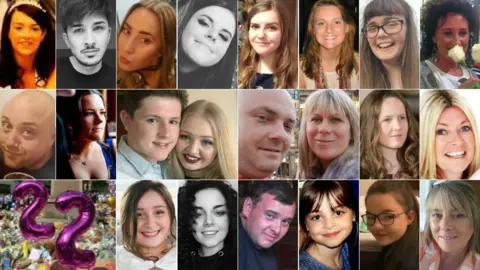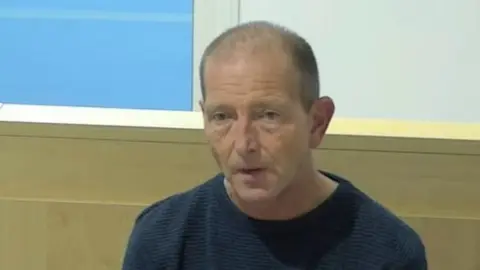Manchester Arena Inquiry: PC felt ignored by paramedics at bomb scene
 Family handout
Family handoutA police officer felt "ignored" by ambulance staff when he asked for assistance in moving a Manchester Arena bombing victim, the inquiry has heard.
John Atkinson, 28, suffered severe leg injuries in the bombing but the inquiry heard he might have survived with timely medical intervention.
PC Leon McLaughlin went for help after fellow officers struggled to remove Mr Atkinson from the bomb scene.
The officer told the inquiry he felt "frustrated" by the response.
Mr Atkinson was one of 22 people killed when Salman Abedi detonated a device at the end of an Ariana Grande concert on 22 May 2017.
The inquiry heard fellow officers could not get in a lift with Mr Atkinson on a makeshift stretcher to take him down to the casualty clearing area at Victoria railway station.
Footage from PC McLaughlin's body-worn camera showed him approaching consultant paramedic Dan Smith, the operational commander for North West Ambulance Service (NWAS).
He asked: "Excuse me, I know you're busy, we've got someone stuck on the first ground, two fractures to his legs. We just can't move him."
 Manchester Arena Inquiry
Manchester Arena InquiryPart of the conversation was inaudible but Mr Smith is heard to reply: "Just leave him there for now, blanket him up and leave him there."
PC McLaughlin told the inquiry he asked him where he could find blankets but did not get a response from Mr Smith, who moved on to have a conversation with someone else.
He approached another paramedic but was informed there were no blankets available.
When asked how that made him feel, the officer told the hearing: "Obviously, they were busy and they have their procedures... I felt frustrated, I felt ignored."
Mr Smith told the inquiry he could not recall any interaction with PC McLaughlin but explained he was "comfortable" at the time with the system that had been set up to move patients out of the City Room foyer, where the bomb was detonated.
 Family handouts
Family handoutsThe chairman of the public inquiry Sir John Saunders asked Mr Smith: "We know it's at least a strong possibility that had Mr Atkinson got the right treatment sooner, that he would have survived.
"So a person has died unnecessarily and at a time when North West Ambulance were at the scene.
"That is not a situation which should happen is it? So why did it happen, and why did it go wrong, and what was the problem with the system?"
'Truly sorry'
Mr Smith told the inquiry: "All the paramedics wanted to do their very best. Mr Atkinson's death will remain with his family for a very long time, and I am truly sorry if any decision I made impacted on his survivability."
The public inquiry heard healthcare worker Mr Atkinson had lost a significant amount of blood as he laid in agony on the foyer floor for 47 minutes before being carried downstairs.
About 20 minutes later, he went into cardiac arrest and was taken to Manchester Royal Infirmary, the inquiry was told.
A trauma team of clinicians was waiting on his arrival six minutes later but they were unable to save him and he was pronounced dead at 00:24.
The inquiry previously heard a member of the public, Ronald Blake, used his wife's belt and a T-shirt to try to stem the bleeding.
 Manchester Arena Inquiry
Manchester Arena InquiryCardiology expert Dr Paul Rees told the inquiry on Thursday: "If it had been possible to extract him from the scene and deliver him safely to a pre-alerted trauma team with access to extensive blood products before cardiac arrest ensued, then survival might have been possible."
A panel of blast wave experts also believed Mr Atkinson could have survived with timely medical intervention and the applying of effective tourniquets on both legs.
An initial post-mortem examination concluded Mr Atkinson died principally from the effects of blood loss from his leg wounds.
He also had an underlying heart condition but experts do not believe that this caused his death.
The inquiry continues.

Why not follow BBC North West on Facebook, Twitter and Instagram? You can also send story ideas to [email protected]
